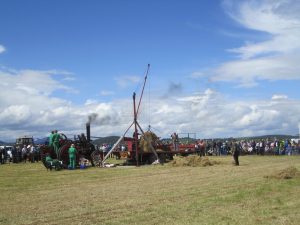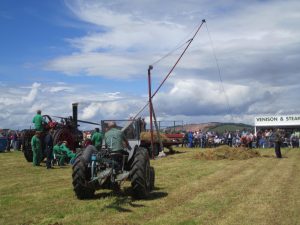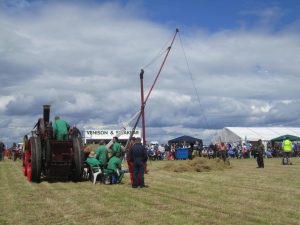In the 1880s and 1890s there were a number of new developments in hay making machinery that were to have a profound impact on the hayfield for many decades to come. One of these was the horse fork for the hay shed, an implement that came from America and was widely adopted in Scotland in a very short time. It was to be used in Scotland for many decades.
The North British Agriculturist described its introduction and use in an article published on 26 May 1877. It is worth quoting it at length:
“The hay shed horse fork
In America, the home of the horse fork, it is used to a much greater extent for storing hay inside hay-sheds or barns than what it is for outside ricks or stacks. Hay is a food in daily use throughout the whole winter, and must be so stored as to be easy of removal. Where the winters are severe, the ground covered with snow several feet deep for many months of the year, and snowstorms of frequent occurrence, outside stacking of hay is not in much repute, barns being much handier in severe weather. During recent years sheds for the storage of hay have been largely adopted on dairy and other farms here, their advantage being that the crop is always protected against rain, and is at any time ready for removal to the cattle; whereas with ricks the hay must be covered with a tarpaulin or straw every time a portion is removed-both methods entailed a good deal of expense in labour and material, as in a storm the tarpaulin cannot be kept on, and very soon goes done, while the straw, the quantity required to make it water-tight is very tight, and the waste of both labour, hay, and straw something excessive.
During the past season I had on trial an American grapple and spear-fork from a friend who had them direct from Canada some years ago, and must say I was particularly well pleased with both of them. The American double spear-fork is only about 2 ½ feet high and 1 ½ feet wide, either full or empty; and the grapple, although taking up more room than the spear-fork, does not take much more than can often be spared inside a shed. The American forks have been specially designed to take up little room, and for that reason are eminently suited for working inside sheds or barns. Seeing that hay sheds of Dutch barns, are now so common in. many districts, I think the American hay-shed horse-fork only requires to be known to be appreciated, and that it only requires time to be adopted in most of them. Where a shed has been built in a style suitable for the working of the horse-fork, one can be bought and erected at one-quarter of the cost it takes to purchase a pole and gear for outside use. Unless an iron rod, running from one end of the shed to the other, all the parts can be taken from one shed and erected in another on a few minutes. Sheds in which it is intended to work the horse-fork should have the space under the roof, from the ridge to at least the level of the wall plates, free of all obstructions in the shape of cross-beams. At either end of the shed short joists or balks are bolted on to the second outside pair of couples, at from 6 to 7 inches below the ridge, and between the pieces thus erected an iron rod, half inch in diameter, is stretched, by passing it through a hole in each cross piece, and tightening it up by a nut and screws at both ends. The rod generally passes through other cross pieces, placed at every second, third, or fourth division of the shed, according to its length. These inside pieces are not only useful as supports for the rod, but are absolutely necessary for the economical working of the fork, as will immediately be shown. On this rod runs a small carriage, about a foot in length, and having two grooved wheels, the wheels being above and the weight below, like an ordinary sliding door, only the two wheels are almost close together. At the one end of the carriage there is a spring latch or sneck, which catches a projecting piece of iron on one of the cross bars supporting the iron rod. These cross pieces are fixed immediately above where the cart is expected to be unloaded, and are for the purpose of holding the carriage in one position while the fork is ascending and descending. The latch acts very much like an ordinary door latch, only it is held firmly in its place by a spring, whether or not to has a held of the stop.
On the underside of the carriage there is also another, working in connection with the first, but so arranged that when the one is closed the other is opened. From this latch, on the under side of the carriage, hangs a block or pulley, after the style of an ordinary ship single block, but made of iron, and of a very near and light pattern. On the upper side of this block is an eye, thorough which, when locked, passes the bolt of the latch on the under side of the carriage; while on its under side is a hook on which to hang the fork. The hoisting rope is attached to one end of the carriage, from which it passes through the block under the carriage, and then over another pulley on the carriage, immediately below the iron travelling rod, thence it is led in any direction to which the power is easily applied. In working, the carriage is brought forward to the stop, which the latch at the end immediately takes hold of, while at the same instant the latch on the under side relieves the block hanging to it, when the weight of the fork pulls it and the rope out till it reaches the load or the ground. The block always hangs in a perpendicular position, owing to the weight of the fork and load being on the under side. When the horse moves forward after the fork is loaded, it rises in a perpendicular line until the eye on the block strikes the latch on the under side of the carriage. This latch, on bring struck by the eye of the block, immediately opens and takes hold of it, while at the same instant the latch at the end lets go its hold of the stopping iron, when the carriage with its load, hanging close under, at once is pulled by the onward movement of the horse to the first, second or any division of the shed in which it is desired to deposit the load. On reaching the proper position the attendant pulls the cord, when the load drops. The carriage is then pulled back to the stopping iron by the same cord which relieved the load, when the fork again drops and is ready to be reloaded. The latches are so arranged that the one at the end never fails to catch the stop, nor the one in the middle to catch the block, neither does the one let go its hold before the other has got a hold of the load; the whole being the most beautiful piece of automatic catching and letting go, done with simplicity and certainty, which it is possible to behold. The carriage being immediately under the ridge of the roof, and the load close up to it, the smallest possible space is taken up by both. A fork capable of giving satisfaction inside a shed must not only be able to take a full load, but at the same time must be of such a size as to be capable of working in a small space, not only in regard to height, but also width. Scarcely any fork could perform these duties to greater advantage than does the double spear, which has the extra superiority of being light, strong, and cheap. Forks for working inside sheds only require to be seen to be appreciated; and although the height to which hay is built in a shed is generally less than what is done in a rick or stack, still the work is as heavy, and it can be both lightened and cheapened by the adoption of the horse-fork. For filling silos, where they are high above the ground, these forks may also be used with advantage, one rod along the ridge giving sufficient facilities for filling any number of silos under the same roof and in a line with the ridges.
Since adopting the horse-fork I have heard it urged that, although it was no doubt of great advantage on a large farm, it was of no use for a small one. Such, however, is not the case, as, although by its use many persons may be kept employed, it can still be worked by very few when such is necessary. For instance, in a small way, where the hay is on the ground (not in a cart), there is no difficulty in the same person both leading the horse, if a quiet one, and attending to the fork; and as it is utterly impossible to build a rick without at least one man being employed forking, no more are used if this plan be adopted, while double or treble the quantity may be put up. In a small way, this is not all, for a smart boy, with the horse-fork, may elevate as much hay to a height of 20 feet or so as three or four men could do by hand-forks. Then, again, by the use of the rick-lifter, any boy or woman accustomed to lead a horse may bring in as much hay to the yard as at least three men could do by hand-forks and hay waggons. The dry climate and light crops of the American Continent make, no doubt, the working of the binder a matter of much less difficulty with them than with us; but neither their climate, crops, nor people give them any advantage over us in the use of the horse-fork, and we will certainly be standing in our own light if we do not take advantage of these inventions after they have perfected them, and perfected they certainly are, for everything in connection with the horse-fork is turned out by them in the lightest, neatest, and cheapest form possible.”
There were a number of key makers of the hay shed horse fork in Scotland. One of the most important was P. & R. Fleming, Glasgow, a major implement and machine maker with key agencies.
The photos were taken at the Fife Vintage Rally, June 2014



